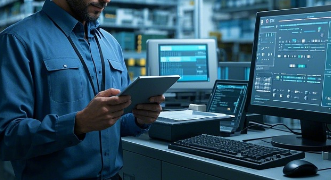Digital Transformation's Role in Small - Batch Electronics Procurement
Introduction
In the fast - paced electronics industry, small - batch production has emerged as a crucial segment. It caters to the needs of startups, prototyping, and low - volume custom projects. However, traditional procurement methods for small - batch electronics have been fraught with challenges. Enter digital transformation, which is rapidly reshaping the landscape of small - batch electronics procurement, bringing about efficiency, transparency, and cost - effectiveness.
The Challenges of Traditional Small - Batch Electronics Procurement
Inventory Management Woes
In traditional procurement, maintaining an optimal inventory for small - batch electronics is a herculean task. Since small - batch production requires a diverse range of components in limited quantities, it's difficult for procurement teams to accurately forecast demand. Overstocking can lead to capital being tied up in inventory, while understocking can halt production lines. For instance, a small - scale electronics manufacturer working on a new line of smart home sensors may miscalculate the need for certain resistors or capacitors. If they overstock these components, they risk the parts becoming obsolete as technology evolves. On the other hand, running out of a critical component can delay product launches, causing missed market opportunities and customer dissatisfaction.
Supplier Search and Selection Complexities
Finding reliable suppliers for small - batch electronics is no easy feat. The electronics supply chain is vast and fragmented, with numerous suppliers offering different quality levels, prices, and lead times. Small - batch buyers often struggle to identify suppliers who are willing to deal with their low - volume orders. Traditional methods of supplier search, such as relying on industry directories or word - of - mouth, can be time - consuming and may not yield the best results. A startup developing a unique wearable device may spend weeks scouring through directories and contacting potential suppliers, only to find that many are not interested in small - batch orders or have sub - par product quality.
Cost Inefficiencies
Small - batch procurement typically incurs higher costs per unit compared to large - scale orders. Suppliers often charge a premium for low - volume orders to cover their setup costs and administrative overheads. Additionally, traditional procurement processes involve multiple manual steps, such as paper - based purchase orders, faxed invoices, and in - person negotiations. These manual processes not only increase the likelihood of errors but also add to the overall cost of procurement. For example, a small - electronics firm may spend extra on administrative staff to manage the paperwork associated with procuring components for a small - batch production run, eating into their profit margins.
The Digital Transformation Landscape in Small - Batch Electronics Procurement
E - commerce Platforms for Procurement
The rise of e - commerce platforms dedicated to electronics components has been a game - changer for small - batch procurement. These platforms aggregate a vast array of components from multiple suppliers, providing buyers with a one - stop - shop experience. They offer detailed product information, including specifications, reviews, and pricing, all at the click of a button. For example, platforms like Octopart and Digi - Key allow small - batch buyers to search for specific components, compare prices across different suppliers, and place orders directly online. This eliminates the need for time - consuming supplier research and negotiation, as the platform often has pre - negotiated deals with suppliers, resulting in more competitive pricing for small - batch orders.
AI - Driven Inventory Management
Artificial intelligence (AI) is revolutionizing inventory management in small - batch electronics procurement. AI - powered software can analyze historical sales data, market trends, and production schedules to predict component demand with greater accuracy. This enables small - batch buyers to optimize their inventory levels, reducing the risk of overstocking or understocking. For instance, an AI - based inventory management system can detect patterns in the demand for certain components in small - batch smartwatch production. It can then automatically reorder components when stock levels are low, ensuring a smooth production process. Some AI systems can also suggest alternative components in case of shortages, further streamlining the procurement process.
Blockchain for Transparency and Traceability
Blockchain technology is making inroads into small - batch electronics procurement by providing transparency and traceability. In a blockchain - enabled supply chain, every transaction, from the sourcing of raw materials to the delivery of the final component, is recorded on a decentralized ledger. This allows small - batch buyers to track the origin, authenticity, and movement of components. For example, in the procurement of rare earth - based components for high - end electronics, blockchain can verify that the materials are sourced from legitimate and sustainable mines. This not only helps in ensuring product quality but also in meeting regulatory requirements, especially in industries where ethical sourcing is a concern.
Virtual Design and Simulation Tools
Digital transformation has also brought about the widespread use of virtual design and simulation tools in small - batch electronics procurement. These tools enable designers and engineers to create and test electronic designs in a virtual environment before placing component orders. By simulating the performance of a circuit or a device, they can identify potential design flaws and make necessary adjustments. This reduces the need for costly physical prototypes and rework, saving both time and money. A small - batch electronics manufacturer developing a new audio amplifier can use virtual design tools to simulate the sound quality, power consumption, and heat dissipation of the design. This way, they can finalize the design and order the appropriate components with confidence, knowing that the product is likely to perform as expected.
The Impact of Digital Transformation on Small - Batch Electronics Procurement
Cost Savings
The digital transformation of small - batch electronics procurement has led to significant cost savings. E - commerce platforms and AI - driven inventory management reduce the cost of supplier search, inventory holding, and order processing. For example, by using an e - commerce platform, a small - batch electronics buyer can save on administrative costs associated with traditional procurement methods. AI - powered inventory management can cut down on inventory - related costs by optimizing stock levels. According to industry studies, companies that have embraced digital procurement tools for small - batch electronics have reported cost savings of up to 30% in procurement - related expenses.

Time Efficiency
Digital tools have greatly improved the time efficiency of small - batch electronics procurement. The ability to search for components, compare prices, and place orders online through e - commerce platforms has reduced the procurement cycle from weeks to days. Virtual design and simulation tools also accelerate the product development process, as designers can quickly iterate on their designs without waiting for physical prototypes. A startup working on a new mobile app - controlled gadget can use digital procurement tools to source components and start production within a fraction of the time it would have taken using traditional methods. This faster time - to - market can give small - batch electronics producers a competitive edge in the market.
Quality Assurance
Blockchain - based traceability and virtual design and simulation tools contribute to better quality assurance in small - batch electronics procurement. Blockchain ensures that components are sourced from reliable and ethical suppliers, reducing the risk of counterfeit or low - quality parts. Virtual design and simulation tools help in catching design flaws early, resulting in higher - quality final products. In the production of small - batch medical electronics, where product quality and safety are of utmost importance, blockchain - enabled supply chains and virtual design tools can be the difference between a successful product launch and a costly recall.
Future Outlook
The digital transformation of small - batch electronics procurement is set to continue evolving. As technology advances, we can expect to see even more sophisticated AI - driven tools that can predict market disruptions, such as component shortages due to geopolitical events or natural disasters. E - commerce platforms may integrate augmented reality (AR) and virtual reality (VR) to provide an even more immersive and interactive procurement experience. Blockchain technology may expand its reach to cover more aspects of the supply chain, including logistics and payment processing. Small - batch electronics producers need to embrace these digital transformation trends to stay competitive in an increasingly global and dynamic market.
In conclusion, digital transformation is playing a pivotal role in streamlining small - batch electronics procurement. By addressing the long - standing challenges of traditional procurement methods, it is enabling small - batch producers to operate more efficiently, cost - effectively, and with higher product quality. The future of small - batch electronics procurement is digital, and those who adapt will thrive in this ever - changing industry.








